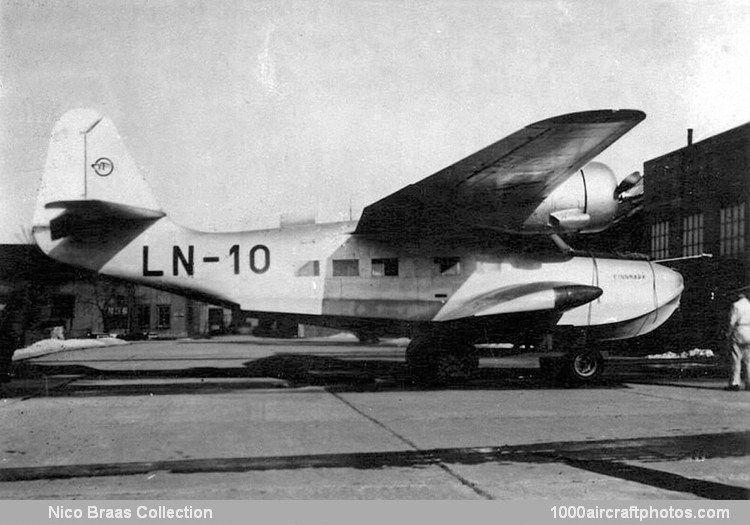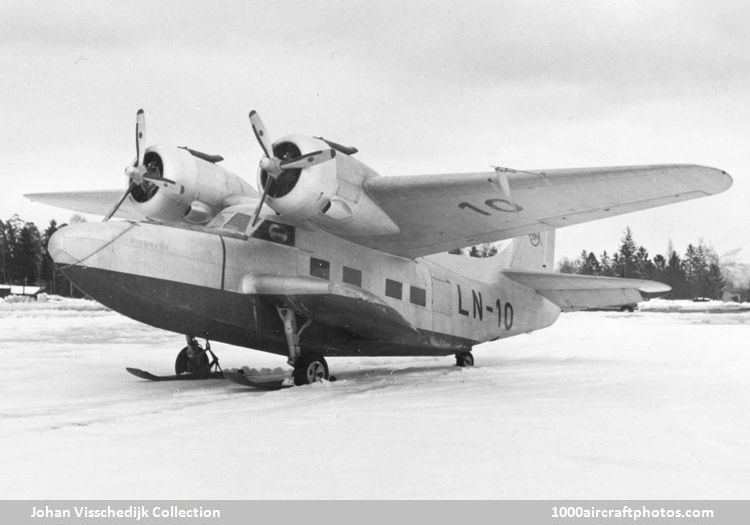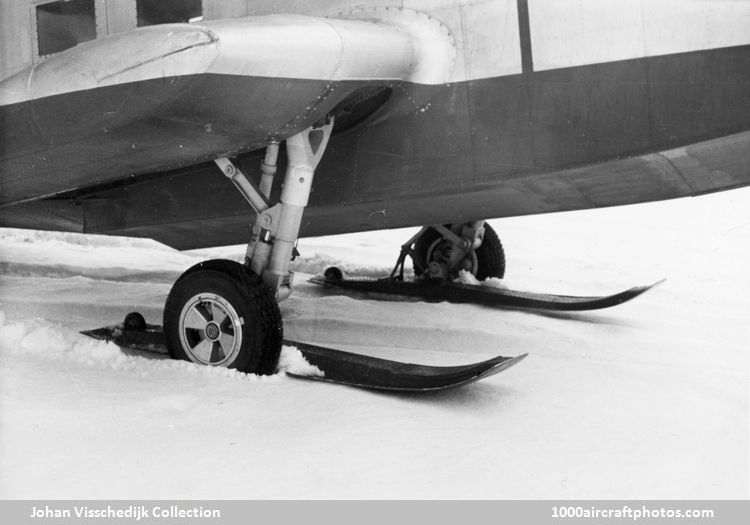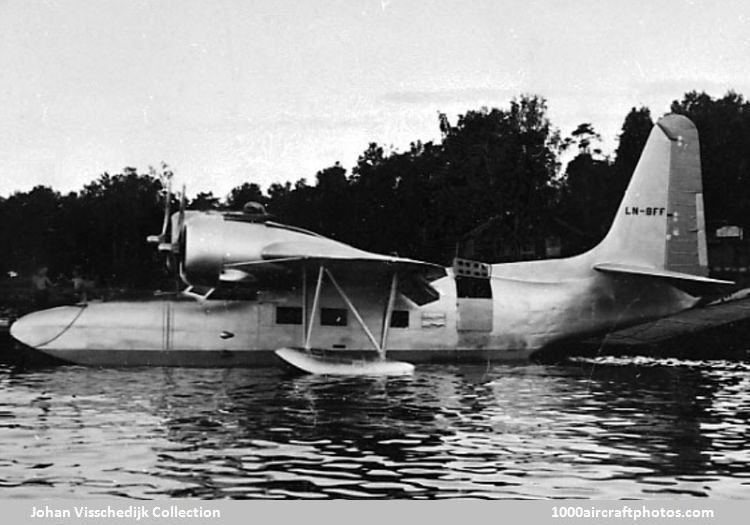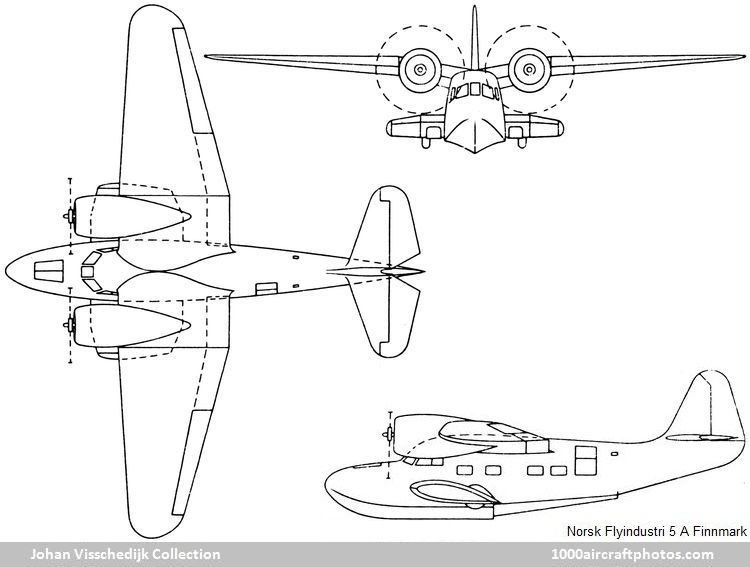12/15/2021. Remarks by
Johan Visschedijk: "The original firm Birger-Hønningsted A/S was established in 1936 at Skoyen, near Oslo, Norway, by the Norwegian aeronautical engineer Birger Hønningstad and before the war two aircraft had been designed. These were the Norge Model A which flew in 1938, and the C-5. The prototype of the C-5 was built in the workshops of Wideröe's Flyveselskap (Wideröe Airline). In 1946 the Hønningstad factory and offices were moved to the Fornebu Airport, Oslo, and in 1947 the name of the company was changed to Norsk Flyindustri A/S. (Norwegian Aviation Industry, Ltd.). Birger Hønningstad became the Technical Manager.
The twin-engined flying boat Type 5 A Finnmark was an original design of Birger Honningstad. Of all-metal construction, the Finnmark was designed for the special climatic conditions prevailing in northern and arctic regions. The design conformed to US CAA Canadian and Scandinavian requirements with respect to the combined wheel and ski amphibian landing gear.
In its original form the aircraft featured large fuselage sponsons and was configured as a pure flying boat with no landing gear. The two radial engines were fitted with two-bladed propellers. Norsk Flyindustri completed the aircraft in 1949.
Finnmark as a flying boat with sponsons (
Johan Visschedijk Collection)
In this form the Finnmark (named after Norway's most northernly county) was first flown on September 17, 1949, under the experimental registration LN-10. The initial flight trials proceeded satisfactorily.
Finnmark as an amphibian flying boat (
Johan Visschedijk Collection)
The next step was to convert the aircraft into an amphibian, fitted with a retractable wheel/ski landing gear. The engines were fitted with
Finnmark's wheel/ski landing gear (
Johan Visschedijk Collection)
This gear was designed and built by Dowty Equipment, Ltd. of Cheltenham, England, and was installed during the winter of 1950/1951. In the same period the two-bladed propellors were also replaced by three-bladed units.
Finnmark (LN-BFF) flying boat with wing floats (
Johan Visschedijk Collection)
During 1954 the aircraft was again modified when the fuselage sponsons and landing gear were removed and two stabilizing floats were added under the wings, thus making it a pure flying boat again. After receiving a CofA, Norsk Flyindustri had the Finnmark registered as LN-BFF on July 14, 1955, but it was operated by Vestlandske Luftfartsselskap A/S (Western Airline Ltd.) of Bergen. January 31, 1958, the aircraft was transferred to airline Norrønafly of Oslo. The CofA expired on November 22, 1961 and LN-BFF was withdrawn from use, the registration was cancelled on March 28, 1966 and the aircraft was scrapped.
A refined model 5 A-II was designed, but never constructed.
Type: Twin-engined amphibian flying boat.
Wings: High-wing cantilever monoplane. Constant chord center-section and tapering outer sections. All-metal structure. Split trailing edge flaps between ailerons and hull. Statically and dynamically balanced ailerons were fabric covered.
Hull: Two-step all-metal structure with stabilizing sponsons on each side. Hull divided into seven, and each sponson into six, watertight compartments. Main step vented for improved water characteristics.
Tail unit: Cantilever monoplane type. Fin integral with hull. Fixed surfaces were all-metal, the movable surfaces had metal frames and were fabric covered. Adjustable trim tabs in control surfaces.
Landing gear: The detachable hull sponsons, each fastened to hull by four bolts, were later fitted with hydraulically retractable wheel/ski landing gear units. In retracted position the skis were flush with the underside of the sponsons and the wheels protruded slightly below. The landing gear could easily be removed, thereby changing the aircraft into an ordinary flying boat with sponsons. The wings were furnished with fittings for ordinary all-metal wing tip floats making it possible to remove the sponsons with the landing gear and convert the aircraft into conventional flying boat. The tail wheel was fully retractable into a recess in the tail of the hull. The tail wheel could be combined with a small ski.
Power plant: Two 600 hp Pratt & Whitney R-1340 Wasp nine-cylinder radial air-cooled engines, initially driving two-bladed constant-speed airscrews, later replaced by Hamilton Standard Hydromatic three-bladed full-feathering airscrews. Power units were interchangeable right and left. Four welded aluminum fuel tanks in wing center section.
Accommodation: The three cabins had seats for a crew of two and up to twelve passengers. One mail or baggage compartment in the nose of the hull and one toilet or baggage compartment in the rear. Access to bow compartment from cockpit or through bow hatch. The cabins were sound-proofed and provided with controlled heating and ventilation system. The passenger seats could easily be removed so that all space could be used for freight or ambulance work.
